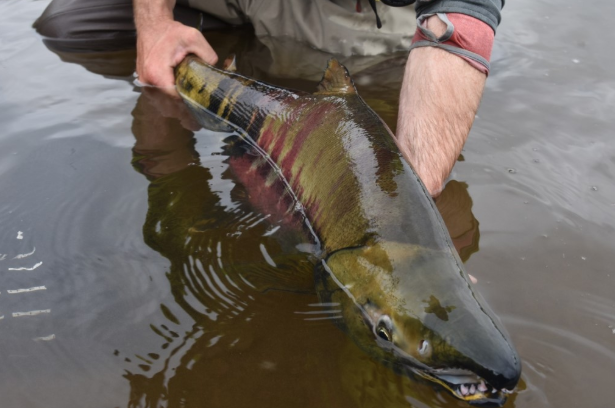Editor’s note: Building off the success of last year’s Native Odyssey campaign, Trout Unlimited sent four of our brightest college club leaders in the TU Costa 5 Rivers Program to explore the home of the world’s largest runs of wild salmon: Alaska. These students are exploring the Kenai Peninsula, Bristol Bay and the Tongass National Forest in pursuit of the five species of Pacific salmon and other native salmonids that call Alaska home. In partnership with Costa Sunglasses, Simms Fishing Products, the U.S. Forest Service, Fishpond USA, and Orvis, these students will seek to unearth, document and share the challenges facing the largest salmon fisheries in the world.
We were running on empty. Three hours of sleep and three cups of coffee for breakfast were all that were keeping me from collapsing on the rocky tundra.
My arms burned and my hands were cramping, but we finally made it. With a shrug of relief I set down the two buckets filled with white fuel and food and took the duffel off of my back. I leaned against one of the buckets, but before I could catch my breath, Chuck, our guide for the week, was yelling at us.
“Hurry up!” He shouted. “We have at least fourmore trips!”
I couldn’t believe what I had just heard. We had to carry all of our gear for the eight-day float across the tundra to the river and I was already exhausted. How were we going to be able to carry all of our gear when one trip was a half mile?
Somehow, we made it to the end of the portage. We thought that was the end of the work, but it was only the beginning. We pumped up the rafts and organized our gear and were immediately faced with challenges on the raft. Chuck decided to take us through a narrow back channel with low flows to get to the main river so we did not have to carry gear any farther, but it meant sliding our rafts over many obstacles including beaver dams and bushes.
This may sound like a terrible time to some, but it made the entire trip that much sweeter for me. Once we carried our rafts over all of the obstacles and made it to the main channel of the river, I was filled with joy. Immediately, we saw the subtle ripples resulting from salmon and grayling rising to insects skirting across the surface of the water. Our hard work had paid off.
This was the first time I had truly set my eyes on the Koktuli River, and I would not have been as amazed if we could have reached the river from a parking lot.
Overcoming many of the challenges that we faced also gave me a new perspective on the challenges that salmon face. We had the privilege of taking two flights to get to our put-in on the Koktuli, while the salmon make an enormous journey from the open ocean, swimming hundreds of miles upstream back to their birth place to spawn.
Before the float trip, I saw firsthand how salmon brought the people together. Now, I got to see how the salmon contributed to the environment. We ran into salmon carcasses on the river that had been eaten by bears. Those carcasses were now filled with insects that would later feed the salmon fry in the river. The same fry (as well as salmon eggs) sustained very healthy populations of Dolly Varden, rainbow trout and Arctic grayling.
The entire ecosystem revolves around the salmon, and it was truly incredible to come into contact with salmon on their journey.



